
Counter-clockwise from top right: a king cobra, an artist’s impression of a titanoboa, and an anaconda. The titanoboa was the largest known snake ever to have existed. (Image credit: Dikky Oesin/MR1805/4uves/Getty Images)
10. King cobra (5.7 meters)
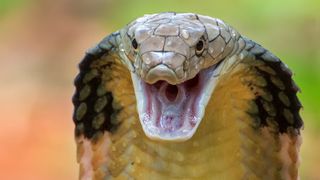
Rearing up to display its flared hood and venomous fangs, the king cobra ( Ophiophagus hannah ) cuts a menacing figure — and not just because its bite is powerful enough to kill an elephant. Native to Asia, king cobras can grow more than 16 feet (5 meters) long, according to the Smithsonian’s National Zoo and Conservation Biology Institute. The longest king cobra ever recorded was a captive snake that reached 18.7 feet (5.71 m) at the London Zoo in the late 1930s, according to Guinness World Records — about the length of a shipping container. It was killed at the outbreak of World War II to prevent it from escaping into the city if the zoo was bombed.
Venomous snakes don’t typically reach giant sizes. Their ability to immobilize prey with a single bite means they typically don’t need to rely on size or strength to feed, Campbell said. However, king cobras are an “exception to the rule,” he said, making them the longest venomous snake on Earth.
Related: What is the difference between poison and venom?
9. Burmese python (5.7 meters)

Burmese pythons ( Python bivittatus ) are one of 41 species of pythons found worldwide. Burmese pythons are native to Southeast Asia and begin life in trees , but as they reach adulthood their size forces them to come down to the ground. The largest Burmese python on record was a captive snake named Baby, which measured 5.74 m (18 ft) long, according to the Guinness Book of World Records . In the wild, these snakes often reach over 4.9 m (16 ft) in length, large enough to hunt alligators .
The largest Burmese python ever found in Florida , where it is an invasive species, was captured in 2022. It weighed 215 pounds (97.5 kg) and measured 17.7 feet (5.4 m) long.
As if that weren’t impressive enough, researchers studying Burmese pythons in the Florida Everglades (where pythons that were initially imported as pets have become invasive) found that these snakes also have extraordinary homing instincts: Relocated pythons can follow their noses back home for more than 20 miles, the researchers wrote in a 2014 study in the journal Biology Letters .
8. Cuban boa (up to 6 meters)
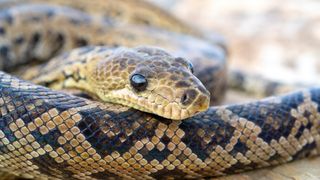
These iridescent-scaled boas, endemic to Cuba, are the largest snakes in the Caribbean, according to the Lake District Wildlife Park . Weighing more than 66 pounds (30 kilograms) and growing up to 18.5 feet (5.65 m) in length, according to researchers publishing in the journal Reptiles & Amphibians (some reports claim they can grow to more than 19.6 feet ( 6 m)), Cuban boas ( Chilabothrus angulifer ) spend much of their time coiled in tree branches or foraging for lizards and rodents on the ground.
Cuban boas are also notable for their unique hunting methods: They are the only snakes that hunt in packs . In 2017, researchers described how these otherwise antisocial animals would strategically band together to form a barrier at the entrance to a cave in a Cuban national park, blocking the flight path of bats. This allowed the snakes to jump and snatch the bats in mid-air.
7. Indian Python (up to 21 feet)
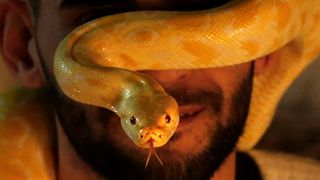
Possibly the species that inspired Kaa, the enigmatic talking snake from Rudyard Kipling’s “The Jungle Book,” the Indian python’s ( Python molurus ) gargantuan storybook size is only a partial exaggeration: These snakes can grow up to 20.9 feet (6.4 m) long and weigh nearly 220 pounds (100 kg), according to ADW. That’s about the weight of a newborn elephant calf.
Native to the forests of India, Pakistan, Sri Lanka and Nepal, they are close relatives of Burmese pythons, and like them, their faces contain structures called “heat pits” equipped with a sensitive membrane that can detect infrared radiation emanating from warm-bodied animals up to 3.2 feet (1 m) away, according to a 2010 study in the journal Nature . This adaptation helps guide the stealthy, night-hunting reptiles to their prey.
6. Reticulated Python (32.8 feet)
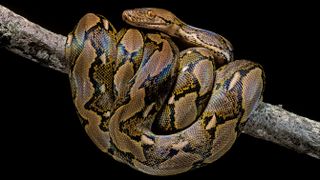
Another snake native to South Asia, the reticulated python ( Malayopython reticulatus ), decorated with a pattern of repeating rhombuses that gives it its name, is widely acknowledged to be the longest snake on Earth today. A 1912 account claims that a captured python measured 10 m long (the length of a typical school bus), although this figure is difficult to verify.
According to the UK’s Natural History Museum, reticulated pythons typically reach more than 6.25 m (20.5 ft). The longest reticulated python in captivity measured 7.7 m (25.2 ft), according to the Guinness Book of Records.
Their size, coupled with their temperamental nature , has proven lethal to humans on occasion: In one incident in 2018, a woman in Indonesia was discovered , fully clothed, in the belly of a swollen python. However, these creatures can also be tender. Like other python species, females delicately circle their eggs and rhythmically contract their muscles to generate heat that is transferred to the hatchlings, increasing their chances of survival against the cold, according to the San Diego Zoo .
5. Green Anaconda (up to 33 feet)
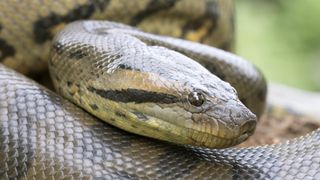
Green anacondas ( Eunectes murinus ) slither silently through the swamps and streams of the Amazon, where they can live long enough to reach 9 meters (30 feet) in length .
If historical records are anything to go by, they’re probably not as long as reticulated pythons. However, green anacondas are the heaviest snake species on Earth today, with some weighing up to 550 pounds (250 kg), according to the Smithsonian’s National Zoo and Conservation Biology Institute — the equivalent of a small grand piano. The massive snakes use that massive bulk to constrict prey like capybaras, alligators and deer.
There is no official record of the largest green anaconda, but in 2016, construction workers in Brazil came across a snake estimated to have been 10 metres long and weighed 399 kg.
Contrary to popular belief, constriction does not cause death through suffocation alone. “The sheer muscle mass of their bodies enveloping their prey basically causes a heart attack. Essentially, it stops the heart’s rhythm and circulation,” Campbell said. “That will immobilize the prey and then they will take their time swallowing it whole, usually head first.”
4. Gigantophis garstini (up to 32 feet)
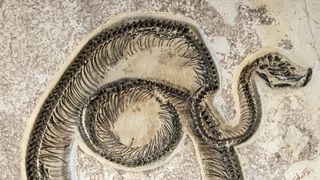
While modern-day snakes can reach incredible sizes, prehistoric snakes surpassed most of these current records. Gigantophis garstini , for example, was a hulking beast that slithered around 40 million years ago on a body that researchers estimate was 7 to 10 meters long, according to a PLOS blog post.
This constrictor snake, discovered in Egypt in 1901, was able to wrap its massive body around prey like its older ancestors, the tapir-sized elephant, and eat it whole. Researchers discovered that Gigantophis was related to another extinct giant species called Madtsoia , fossils of which were discovered in India, suggesting that the giant snakes’ reign of terror also extended across parts of Asia. For nearly 100 years after its discovery, Gigantophis garstini held the title of the world’s largest snake — until even larger specimens turned up.
3. Palaeophis colossus (11.8 meters)
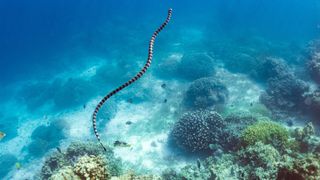
Giant snakes weren’t limited to land: Earth’s prehistoric seas also contained leviathans, such as Palaeophis colossaeus . This sea serpent traversed an ancient ocean that once stretched over parts of North Africa 100 million years ago. When its fossilized skeleton was discovered in the present-day Sahara Desert , researchers calculated from samples subsequently collected during field trips in 1999 and 2003 that this species would have reached more than 39 feet ( 12 m) long, according to research published in the journal Acta Palaeontologica Polonica. That makes it the longest sea snake ever found — and one of the longest snakes known, period.
The snake’s head was never discovered, but from its skeleton, researchers determined that the giant creature’s mouth would have been large enough to consume small whales whole.
Their descendants are tiny in comparison. Modern sea snakes rarely measure more than 2 metres.
2. Titanoboa cerrejonensis (42.7 feet)
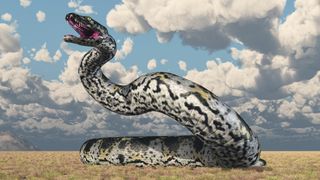
A T. rex -sized snake weighing 1.25 tons (1.13 metric tons), Titanoboa cerrejonensis is not a fictional monster invented for a horror movie, but a real creature that once slithered through the rainforests and rivers of South America. Titanoboa was one of the largest known snakes to have ever existed .
Dating back 60 million years, this snake was the prehistoric grandfather of today’s anacondas and boas in the region. Its roughly 250 vertebrae formed a massive 13-metre-long body that would have fed on a diet of crocodiles and river fish. It is estimated to have weighed a whopping 1,130 kg, according to Indiana University.
— 10 of the deadliest snakes
— A chilling video reveals the moment a 1.5-metre alligator carcass was cut from the stomach of a dead python
—The cobra bites the boy, the boy bites it back (the boy was fine, the snake was not)
Its fossilized remains were discovered in the early 2000s, embedded in the rocks of the Cerrejón Formation, a geological landscape in Colombia. But there may still be other titans lurking there.
“I don’t rule out the possibility that there is another snake out there that is bigger or larger than Titanoboa,” Campbell said. “We just haven’t found it yet.”
1. Vasuki Indicus (up to 50 feet)

While Titanoboa held the record as the largest known snake for over a decade, a new contender was announced in April 2024. Unearthed from a mine in India, Vasuki indicus , at its highest estimate, would have been 6.5 feet (2 meters) longer than Titanoboa .
This extinct giant snake is named after Vasuki, the mythical king of snakes in Hinduism. Its fossilized vertebrae indicate that it was a fully grown adult and was probably between 11 and 15 meters long. This makes V. indicus the largest known snake to have ever existed .
Vasuki lived about 47 million years ago. It belongs to an extinct family of snakes called Madtsoiidae that emerged in the late Cretaceous period (between 100.5 and 66 million years ago) in Africa, India, Australia, South America and southern Europe.
Researchers believe it had a broad, cylindrical body and would have lived on land. It was probably an ambush predator that killed its prey by constriction , similar to modern snakes such as boas and pythons.




